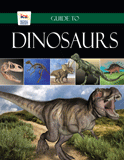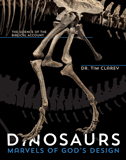
Why Birds Are Not Dinosaurs (And Why It Matters)
One of the primary points of contention between us and young-earth “evolution” (YEE) is the question of whether birds are dinosaurs. Many within what we call the YEE subcommunity of the young-earth creationist camp have made the claim that dinosaurs had feathers and/or that modern birds are dinosaurs in some sense. But is this claim valid? We submit that no feathered dinosaurs have been found and that dinosaurs and birds represent distinct groups that do not and cannot overlap.
Among those most prominently saying that, in some sense, birds are dinosaurs is Dr. Matt McLain, a professor at The Master’s University. Dr. Gabriela Haynes (Answers in Genesis’ on-staff paleontologist) wrote an excellent response to some of Dr. McLain’s arguments last year. Unlike many of his colleagues in the YEE community, Dr. McLain has gone so far as to say that birds can be considered dinosaurs. “Similarly, we can recognize birds as very similar to dinosaurs (in fact, we could even say birds are a type of dinosaur) without implying their evolution. We are just saying that birds are more similar to dinosaurs than they are to any other creatures.”1 While he is careful to say that he does not mean that birds evolved from dinosaurs, there are huge problems with this statement. The most obvious one is from Scripture itself.
Redefinitions
Dr. McLain and his colleagues have also considered questioning the meaning of the terms dinosaur and bird: “We must ask what the terms birds and dinosaurs actually mean, rather than reflexively say that ‘birds’ are--or are not--‘dinosaurs.’”2 That approach of questioning those terms, we claim, relies on evolutionary ideas and not on the careful analysis of the evidence or Scripture. And not only have YEE assertions borrowed the definitions of dinosaur and bird from an evolutionary perspective but also that of the word feather. Consequently, we have determined that they have interpreted the evidence of the so-called feathered dinosaurs through an evolutionary perspective.
Dinosaurs are land-dwelling animals. That means they were made on day six of creation (Genesis 1:24–25). Almost all birds are flying creatures to some degree, and they all have wings. Therefore, they most likely were all made on day five (Genesis 1:20–22).
Dinosaurs are land-dwelling animals. That means they were made on day six of creation (Genesis 1:24–25). Almost all birds are flying creatures to some degree, and they all have wings. Therefore, they most likely were all made on day five (Genesis 1:20–22). By saying or agreeing with the evolutionary claim that birds are dinosaurs or are most similar to dinosaurs, Dr. McLain is mixing groups made on different days of creation. Further, he is lumping groups that Adam would have been able to distinguish. Remember in Genesis 2 that God brought the animals to Adam to name. This implies that Adam was capable of both naming them and distinguishing between them by sight. There is no reason why dinosaurs and birds should be considered similar unless it is presumed a priori that some dinosaurs had feathers. If that assumption is rejected (as it should be), there is little similarity between an Allosaurus or Stegosaurus and a penguin or cardinal. This fits with the scriptural implication that Adam could visually distinguish between groups.
Another significant problem with arguing that birds are dinosaurs is the cultural context of the claim. While Dr. McLain may think that making the above statement does not imply evolution, the public is inundated daily with evolutionists making the exact same claim. The public knows what an evolutionist means when he claims birds are dinosaurs: that birds evolved from dinosaurs. When they hear Dr. McLain say it, most will still understand it this way as he is making the same claim, although it is more palatable to Christians since it is coming from a young-earth Christian.
Further, Dr. McLain’s statement represents a rhetorical device known as motte and bailey. The motte is the more defensible position, the one harder to criticize, and the one rhetorically retreated to when pressure comes. The bailey is the fertile ground around the motte: a place where ideas can be easily planted. As an example of how this works, social justice activists push critical race theory (CRT) into the public schools—the bailey. Then, when parents object, the activists retreat to the motte and claim to only be teaching about racism, which no one should have a problem with. Dr. McLain is doing something similar here. “Birds are dinosaurs” is the bailey; “birds are more similar to dinosaurs than anything else” is the motte. Unlike the social justice example, Dr. McLain is likely not doing this deliberately or maliciously, but it is the rhetorical device in play nonetheless.
Structural Problems
Dr. McLain’s primary argument is over whether dinosaurs had feathers. He believes they did and has coauthored several papers making this claim, the most famous of which was published in 2018.3 In this article, Dr. McLain and his coauthors argued from statistical baraminological analysis that there were groups of dinosaurs that were feathered. In so doing, they made some serious methodological errors and ignored the arguments of even evolutionist experts on the topic.4 Now this can be somewhat technical for some, but it needs to be stated. In the feathered dinosaur paper, Dr. McLain et al. made an edit to the baraminology program that had never been done before. They changed a parameter—something that had never been tested—and assumed everything would be fine. While that may be true, without testing, there is no way to know. Further, in baraminological analysis, a tetrahedral-shaped MDS plot is supposed to indicate the dataset is uninformative5 or biased,6 yet multiple plots within this paper show a tetrahedral shape. By precedent in statistical baraminology, at least these sub-datasets should have been rejected. Yet they were not, which brings major problems into their results.
Feathers are highly complex structures. Many of the so-called feathers are not featherlike at all and are best described as “fibers.”
Even laying aside the methodological problems, the claim that dinosaurs had feathers is extremely problematic, yet Dr. McLain is sadly not the only one to make it.7 Feathers are highly complex structures. Many of the so-called feathers are not featherlike at all and are best described as “fibers.” Even some evolutionists argue against them being feathers.8 The only way to “make” them feathers is by redefining the word feather.
To confuse matters more, some so-called dinosaurs have unambiguous feathers. That does not mean that dinosaurs have feathers though, because these so-called dinosaurs not only have pennaceous feathers but also possess wing structures capable of either flight or gliding and a tail structure like the ones found in fossil birds—their anatomical structure is not at all like, say, a Tyrannosaurus.9 Therefore, these organisms represent extinct kinds of birds, not dinosaurs.
Using the evolutionary dinosaurian classification, which includes birds, is very problematic and represents an unnecessary ceding of ground to the evolutionary narrative as well as a confusing narrative for the churchgoer. When even members of the evolutionary community question the idea that dinosaurs had feathers with sound, peer-reviewed papers, it begs the question of why some in the creationist community would accept it. The only reason to do so is if some of the same assumptions that drive the evolutionary model are smuggled into the creation model—namely that some dinosaurs had feathers. And for what purpose? If the assumption that some dinosaurs had feathers is removed, the entire evolutionary argument falls away, as does the “young-earth evolution” argument dependent on it.
Dinosaurs had no feathers, and claiming they did actually requires reliance on evolutionary interpretations of fossils that should not be accepted by creationists.
Footnotes
- Matthew A. McLain, “Feathered dinosaurs and the creation model,” Journal of the Biblical Creation Trust 2 (2020): 2–8, e-origins_vol2_pp2-8_feathered dinosaurs-v3.indd (biblicalcreationtrust.org).
- Matthew McLain, Matt Petrone, and Matt Speights, “Feathered Dinosaurs Reconsidered: New Insights from Baraminology and Ethnotaxonomy,” The Proceedings of the International Conference on Creationism 8, no. 31 (2018): 472–515, https://doi.org/10.15385/jpicc.2018.8.1.37.
- McLain, Petrone, and Speights, “Feathered dinosaurs reconsidered,” 472–515.
- McLain et al. published their paper in July of 2018. In April 2018, a technical article on the topic was published, refuting many of the claims published in their paper. As best we can find, Dr. McLain and the YEE community has ignored this article and continue to claim there is good evidence for dinosaurs having feathers, https://creation.com/feathered-dinosaur-debate.
- Todd Charles Wood, Animal and Plant Baramins (Eugene, Oregon: Wipf and Stock, 2008), 57.
- Todd Charles Wood, A Creationist Review and Preliminary Analysis of the History, Geology, Climate, and Biology of the Galápagos Islands (Eugene, Oregon: Wipf and Stock, 2005), 143.
- Todd Charles Wood, The Quest (Nashville, Tennessee: Compass Classroom, 2018), 26–27.
- Theagarten Lingham-Soliar, Alan Feduccia, and Xiaolin Wang, “A new Chinese specimen indicates that ‘protofeathers’ in the Early Cretaceous theropod dinosaur Sinosauropteryx are degraded collagen fibres,” Proceedings of the Royal Society B 274, no. 1620 (August 7, 2007): 1823–1829.
- See Dr. Haynes’ article for an excellent diagram explaining the difference between a dinosaur tail and a bird tail.
Recommended Resources

Answers in Genesis is an apologetics ministry, dedicated to helping Christians defend their faith and proclaim the good news of Jesus Christ.
- Customer Service 800.778.3390
- © 2024 Answers in Genesis







